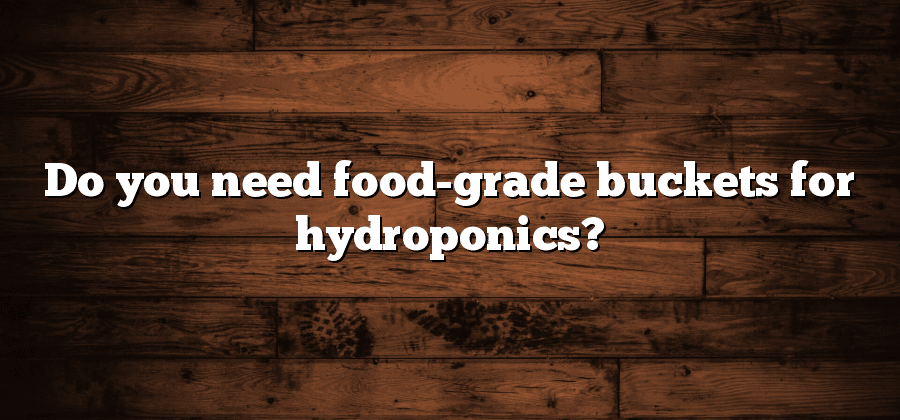Understanding Hydroponics: A Brief Overview
Hydroponics is a method of growing plants without soil, using water and nutrient solutions instead. This allows for precise control of the plant’s environment, leading to optimized growth and increased yields. This system is gaining popularity in agriculture and horticulture industries, as it offers several benefits over traditional soil-based growing methods.
In hydroponics, plants are grown in a variety of mediums, such as perlite, coconut coir, or even air. By directly providing the necessary nutrients to the plants’ roots, growers can avoid issues commonly associated with soil, such as nutrient imbalances and pests. Additionally, hydroponics allows for the optimization of various environmental factors, including temperature, pH levels, and light exposure. These factors can be adjusted based on the specific requirements of different plant species, resulting in healthier and faster-growing plants. This precise control also enables year-round cultivation, making hydroponics a viable option for regions with adverse climates or limited arable land.
Ensuring Safety in Hydroponic Systems
Hydroponic systems have gained popularity among home gardeners and commercial growers due to their efficiency and ability to produce high-quality crops. However, it is essential to prioritize safety when setting up and operating these systems. Safety measures not only protect the growers’ well-being but also ensure the integrity of the crops.
One crucial aspect of safety in hydroponic systems is the proper handling and use of nutrients and chemicals. It is vital to follow the instructions provided by the manufacturers and use protective equipment, such as gloves and goggles, when handling these substances. Additionally, growers should store these compounds in a designated area away from food and beverages to prevent accidental ingestion or contamination. Regular maintenance and inspection of the system’s components, such as pumps and hoses, also contribute to safety by identifying any potential hazards and preventing leaks or malfunctions that may harm the growers or the plants.
Importance of Container Selection in Hydroponics
When it comes to hydroponic gardening, choosing the right container is crucial. The container not only holds the nutrient solution that nourishes the plants, but it also provides support and protection to the roots. Therefore, it is essential to select a container that meets the specific needs of your hydroponic system.
One of the key factors to consider when selecting a container is the material it is made of. Different materials have varying levels of durability, insulation, and resistance to chemicals and UV rays. Common container materials for hydroponics include plastic, glass, and fabric. Plastic containers are popular for their affordability, versatility, and ease of use. They come in various shapes and sizes, making them suitable for different types of hydroponic setups. Glass containers, on the other hand, offer a more visually appealing option, allowing you to observe the plant roots and nutrient solution. Fabric containers, such as grow bags, provide excellent aeration and drainage capabilities, promoting healthy root growth.
Evaluating the Role of Food-Grade Buckets
When it comes to hydroponics, the choice of containers plays a vital role in ensuring the overall success and safety of the system. One commonly used option is food-grade buckets. These containers are specifically designed and manufactured to meet strict food safety standards, making them a popular choice for hydroponic enthusiasts.
The key advantage of using food-grade buckets in hydroponics is their high level of safety and reliability. These buckets are made from materials that are approved for food contact, ensuring that they do not leach any harmful chemicals or substances into the nutrient solution or the plants themselves. This is especially important in hydroponic systems where the roots of the plants are directly exposed to the water and nutrients. By using food-grade buckets, growers can have peace of mind knowing that their plants are not being exposed to any potential contaminants.
Exploring Food-Grade Standards for Containers
Food-grade standards for containers play a crucial role in ensuring the safety and quality of hydroponic systems. The choice of container material is vital as it directly affects the health of the plants and the safety of the produce. The term “food-grade” refers to materials that are deemed safe to be in contact with food. In the context of hydroponics, food-grade containers are those that are safe for growing edible plants as they do not leach harmful chemicals or substances into the nutrient solution.
When it comes to selecting food-grade containers for hydroponics, there are a few key factors to consider. First and foremost, the material used should be non-toxic and free from any harmful additives or contaminants. Common food-grade materials include high-density polyethylene (HDPE) and polypropylene (PP), as they are known for their durability, resistance to chemicals, and low risk of leaching. It is important to note that containers made from other materials, such as PVC or polystyrene, may not meet food-grade standards and should be avoided in hydroponic systems.
In conclusion, understanding food-grade standards for containers in hydroponics is essential for ensuring the safety and quality of the plants and produce. Selecting the right material is of utmost importance to avoid any potential health risks associated with the leaching of harmful chemicals into the nutrient solution. By adhering to food-grade standards, hydroponic growers can create a safe and sustainable environment for their plants and enjoy healthy and nutritious harvests.






